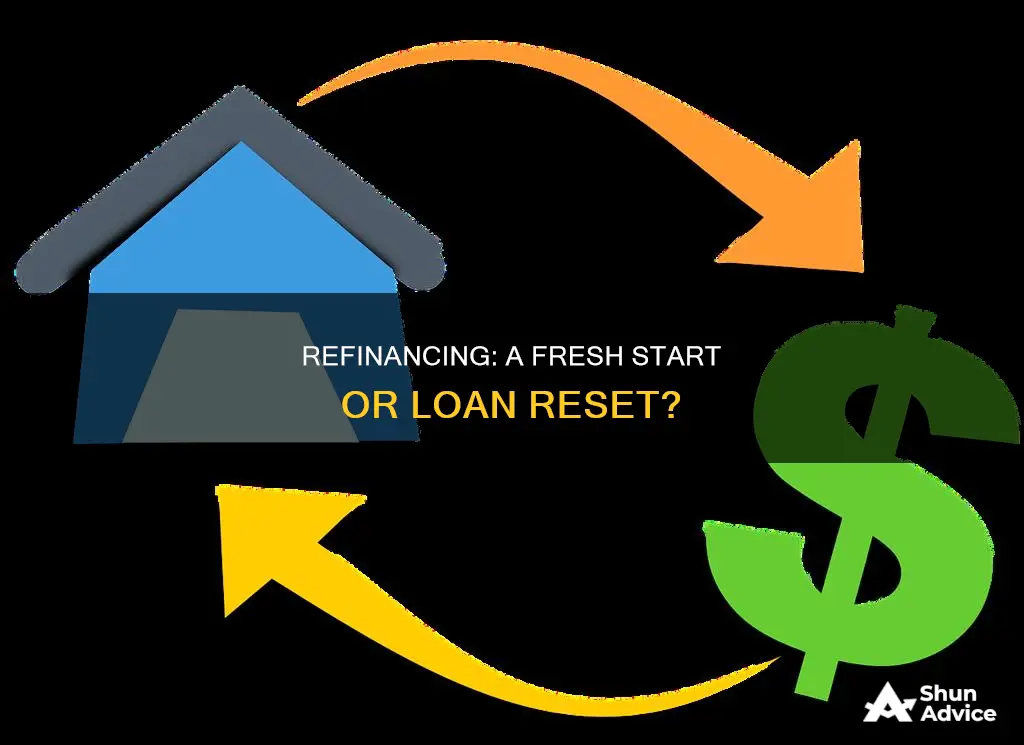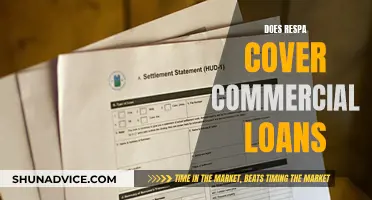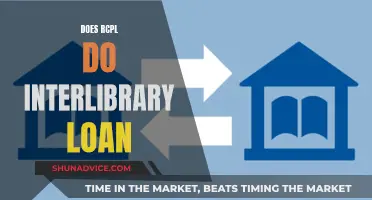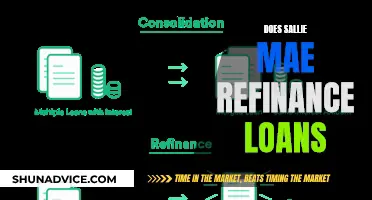
Refinancing a loan can be a great way to save money, pay less interest, or free up room in your budget by lowering your monthly payment. However, it can also extend your loan term and make you feel like you're starting over from the beginning. When you refinance, you replace your current loan with a new one, which could offer a better interest rate, a different loan term, or both. While refinancing does not technically reset the repayment term of your loan, opting for a longer repayment period could result in you paying more interest over time.
What You'll Learn

Refinancing replaces your current loan with a new one
Refinancing involves taking out a new loan with new terms, which means you are essentially starting over from the beginning. However, it does not reset the repayment term of your loan. Instead, refinancing replaces your current loan with a new one.
When refinancing, you can choose a loan term that is shorter or longer than your original loan. For example, if you have 25 years left on your original 30-year loan, you could refinance into a new 30-year loan, or a shorter 20- or 25-year loan. While choosing a longer term can lower your monthly payments, it will result in paying more interest overall.
The right choice depends on your budget and financial goals. If you are looking to free up room in your budget by lowering your monthly payment, a longer-term loan may be a good option. On the other hand, if you want to pay off your loan faster and save money on interest, a shorter-term loan may be a better choice.
It is important to note that refinancing may come with additional costs, such as closing fees, and it can impact your credit score. Therefore, it is recommended to compare rates, terms, and programs from different lenders and calculate the potential savings before committing to refinancing.
Loan Advisor Meetings: Realtors' Presence and Their Importance
You may want to see also

You can choose a new loan term
When refinancing, you can choose a new loan term. Refinancing involves taking out a new loan with new terms, but you're not required to choose a term based on your original loan's term or the remaining repayment period. For example, if you're refinancing your mortgage, you may find that lenders offer several repayment terms, including 10- -, 15- and 30-year terms. You can choose to "restart" with the same term you originally had or decide on a shorter or longer term depending on the corresponding interest rate and monthly payment.
A shorter-term loan can help you qualify for a lower rate and mean you'll pay off the debt sooner, but it will also lead to a higher monthly payment. For instance, if you have 25 years left on your loan and you refinance to a new 30-year term, you can make the equivalent of the 25-year payment, keeping you on track to pay off the mortgage in 25 years. On the other hand, if you need to reduce your payments, you can temporarily switch to the 30-year schedule. A longer-term loan can lower your monthly payments, but it results in paying more interest overall.
The decision to refinance to a shorter or longer-term loan depends on your financial situation and goals. If your goal is to pay the least amount of interest possible or to pay off your loan sooner, refinancing to a shorter-term loan may be beneficial. However, if you're looking to lower your monthly payments, a longer-term loan might be a better option.
It's important to note that refinancing may come with additional costs such as closing costs and fees, so it's recommended to calculate your break-even point before deciding to refinance. Additionally, refinancing can impact your credit score, as it involves opening a new account and potentially closing the old one.
PSECU ATV Loans: What You Need to Know
You may want to see also

Refinancing can lower your monthly payments
Refinancing can be a great way to lower your monthly payments. When you refinance, you replace your current loan with a new one, which can help you secure a lower interest rate and reduce your monthly payments. This is especially useful if you are having trouble making your current payments or want to free up some extra cash each month.
There are a few things to keep in mind when considering refinancing to lower your monthly payments. Firstly, while it can reduce your monthly outgoings, it may also mean that you end up paying more interest overall, as you will be paying interest for a longer period. Therefore, it is important to calculate the break-even point, which is how long it will take for the reduction in your monthly payments to equal the costs of refinancing. If you plan to sell your home before this break-even point, you may not recover the closing costs, so it is important to consider how long you plan to stay in your home.
Additionally, when refinancing, you may have the opportunity to make other changes to your loan, such as switching to a fixed-rate mortgage or borrowing from your available home equity. It is also important to note that refinancing may not always be the best option if you are looking to lower your monthly payments. Sometimes, simply making extra payments towards your principal loan balance can help you pay off your loan faster and reduce your interest payments.
Good credit can be important when seeking approval for a new loan, so it is worth checking your credit score and working on improving it if necessary. This will help ensure you get the best offer when refinancing.
How Realtors Can Help Secure Your Dream Home Loan
You may want to see also

Refinancing can result in paying more interest overall
Refinancing a loan or mortgage is typically done to take advantage of lower interest rates or improve the loan terms, such as the monthly payment or length of the loan. However, it is essential to note that refinancing can sometimes result in paying more interest overall. Here's how:
When you refinance a loan, you essentially replace your current loan with a new one that has different terms. This can include a lower interest rate, a different amount borrowed, or a new loan length. While refinancing can offer benefits such as lower monthly payments, it is important to consider the long-term implications. Opting for a longer-term loan during refinancing can reduce your monthly payments but will ultimately result in paying more interest over the life of the loan. This is because the early years of a loan are dominated by interest payments, and you will be extending the period during which you make these high-interest payments.
For example, consider a situation where you have a 30-year fixed-rate mortgage with an interest rate of 8%. Your monthly payments are $1,419, and over the course of the loan, you will pay $262,648 in interest. If interest rates drop, and you decide to refinance to a new 30-year fixed-rate mortgage at 6%, your monthly payments will increase to about $1,594. While this new loan offers a lower interest rate, you have now extended the loan term, resulting in higher overall interest payments over the full 30-year period.
Additionally, refinancing can lead to paying more interest overall due to the costs associated with the process. There may be origination fees, closing costs, or other expenses involved in refinancing, which can increase the overall cost of borrowing. These costs can be rolled into the new loan, resulting in a higher loan amount and, consequently, higher interest payments over time.
It is worth noting that refinancing does not always reset the repayment term to 30 years. You have the flexibility to choose a shorter loan term during refinancing, which can help you avoid paying more interest. For instance, if you had 25 years left on your original 30-year loan, you could opt for a 20- or 25-year refinance, reducing the total interest paid.
Furthermore, refinancing can sometimes lead to paying more interest due to the structure of interest rates. For example, if you switch from an adjustable-rate mortgage (ARM) to a fixed-rate mortgage at the wrong time in the economic cycle, you could end up paying more in interest. This is because interest rates are cyclical, and debtors with variable-interest-rate products can benefit from falling rates without the need to refinance.
In conclusion, while refinancing can offer benefits such as lower interest rates and improved loan terms, it is important to carefully consider the potential for paying more interest overall. The decision to refinance should be made after evaluating your financial situation, long-term goals, and the specific terms of the new loan.
Quicken Loans: Hard Inquiry or Soft Check?
You may want to see also

Refinancing can be a good option if you have good credit
Additionally, refinancing can provide flexibility in the repayment term. While it may effectively reset the clock on your loan, you are not obligated to choose a term that aligns with your original loan's remaining duration. For example, if you have 25 years left on your original 30-year mortgage, you can opt for a new 30-year term or a shorter one, such as 20 or 25 years. This flexibility allows you to adjust your monthly payments to better suit your financial situation.
Moreover, refinancing can be beneficial if you have built up equity in your home. Lenders often require sufficient home equity to approve a refinance, especially for conventional loans. By leveraging the increased value of your home, you may be able to secure more favourable terms and achieve your financial goals, such as consolidating debt or making necessary expenses.
However, it is essential to consider the potential drawbacks of refinancing. There can be significant closing costs and fees associated with refinancing, which may negate the anticipated savings. Additionally, your credit score may experience a temporary dip due to the hard inquiry and loan closure. Therefore, it is crucial to weigh the advantages and disadvantages and make an informed decision based on your financial situation and goals.
Prodigy's Loan Policy: Can You Get a Second Loan?
You may want to see also
Frequently asked questions
Refinancing a car loan does not restart your loan but it can feel like you are starting from scratch. Refinancing swaps your current loan with a new one, which could mean a better auto loan rate, different loan term, or both.
Yes, refinancing your mortgage replaces your original mortgage with a new one, which means you effectively start the loan over. However, it is still possible to refinance without restarting your loan term.
Refinancing a mortgage can reduce your monthly payments, shorten your loan term, or pull out equity for home repairs or debt repayment. It can also lower your interest rate, which can help you save money.
Refinancing a mortgage can be costly in the long run as you will end up paying more interest over time. It can also take a toll on your credit score.
Having good credit can be important when refinancing as it will help you get approved for a new loan and get better offers. You can also choose the length of the loan when refinancing, it does not have to be the same as your original loan term.







